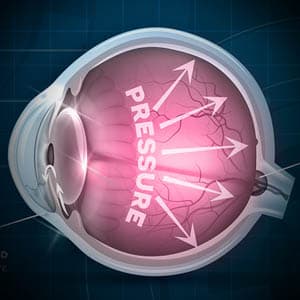Glaucoma is often diagnosed too late, and only after permanent vision loss has occurred.
What is glaucoma?
Glaucoma is an eye disease that causes vision loss from damage to the optic nerve, which is responsible for carrying visual signals between the eye and brain.
The most common form of glaucoma occurs when there is high pressure inside the eye (intraocular pressure, IOP), caused by a build-up of fluid that cannot drain properly.
Glaucoma has the infamous reputation of “robbing” the ability to see, without giving the person time to recognize symptoms and seek their eye doctor’s medical opinion.
It is important to schedule regular eye exams, as new diagnostic tests are available to detect early signs of glaucoma.
What causes narrow-angle glaucoma?
Narrow-angle glaucoma occurs when the iris, the colored part of the eye that surrounds the pupil, bows forward, narrowing the gap between the cornea and the iris, where the eye’s drainage angle is located.
Narrow-angle glaucoma is linked to the following:
Iris plateau
A condition in which the ciliary body, the structure behind the iris that produces the aqueous fluid in the eye, is too far forward in the eye.
The peripheral iris is pushed forward, resulting in a reduced drainage angle and a higher likelihood of occlusion by the front surface of the peripheral iris.
Tumors and other causes
Chronic angle-closure glaucoma can also be caused by a tumor behind the iris, swelling associated with ciliary body inflammation (intermediate uveitis), and changes in the structure of the eye after surgery for a retinal detachment.
Symptoms of narrow-angle glaucoma
A rapid increase in eye pressure typically results in:
- Nausea
- Eye pain
- Red eyes
- Headache
- Blurred vision
- Mid-dilated pupil
- Halos around lights
- Sudden loss of vision
- Sudden severe eye and head pain
If you’re experiencing any of these symptoms, contact an eye doctor near you immediately.
SEE RELATED: What is Glaucoma?
Who is at risk for narrow-angle glaucoma?
A person’s chance of developing narrow-angle glaucoma is increased if they have any of the following risk factors:
- Age: The anterior chamber tends to become increasingly shallow as people age, and the drainage angle may narrow.
- Hyperopia: Farsighted people are more likely to have shallow anterior chambers and narrow angles in their eyes, which increases their risk of narrow-angle glaucoma.
- Heritage: Asians, as well as Inuit and other northern indigenous peoples, naturally have narrower anterior chamber drainage angles. As a result, these populations have a higher incidence of narrow-angle glaucoma.
- Gender: According to Ophthalmology (2010) narrow-angle glaucoma affects 3 times more women than men among Caucasians. Men and women appear to be equally affected among African Americans.
How is narrow-angle glaucoma treated?
Lowering your ocular pressure to a safe, steady level is the best strategy to treat narrow-angle glaucoma.
This can be achieved with:
1. Eye drops
In some cases of narrow-angle glaucoma, topical glaucoma drops may be sufficient.
2. Surgery
If your eye doctor detects signs of narrow-angle glaucoma during an eye exam, glaucoma surgery may be recommended to reduce your risk of angle-closure attacks.
Often laser surgery to create a hole in the iris is the most effective way to quickly lower the eye pressure.
Iridotomy and iridectomy are common procedures for people with narrow-angle glaucoma.
During an iridotomy, surgeons use a laser to make a tiny hole in the peripheral iris to enhance fluid outflow and reduce the danger of angle closure.
An iridectomy is a procedure that includes removing a tiny portion of the iris in order to improve fluid flow in the eyes.
LEARN MORE: Guide to Eye Conditions
Schedule an eye exam with an eye doctor near you who can diagnose if you have narrow-angle glaucoma.
Don’t be concerned when you learn about narrow-angle glaucoma’s fast onset and serious risk. Fortunately there are very successful treatment options.
The sooner any type of glaucoma is diagnosed and treated, the higher the chance of keeping clear vision and healthy eyes.










